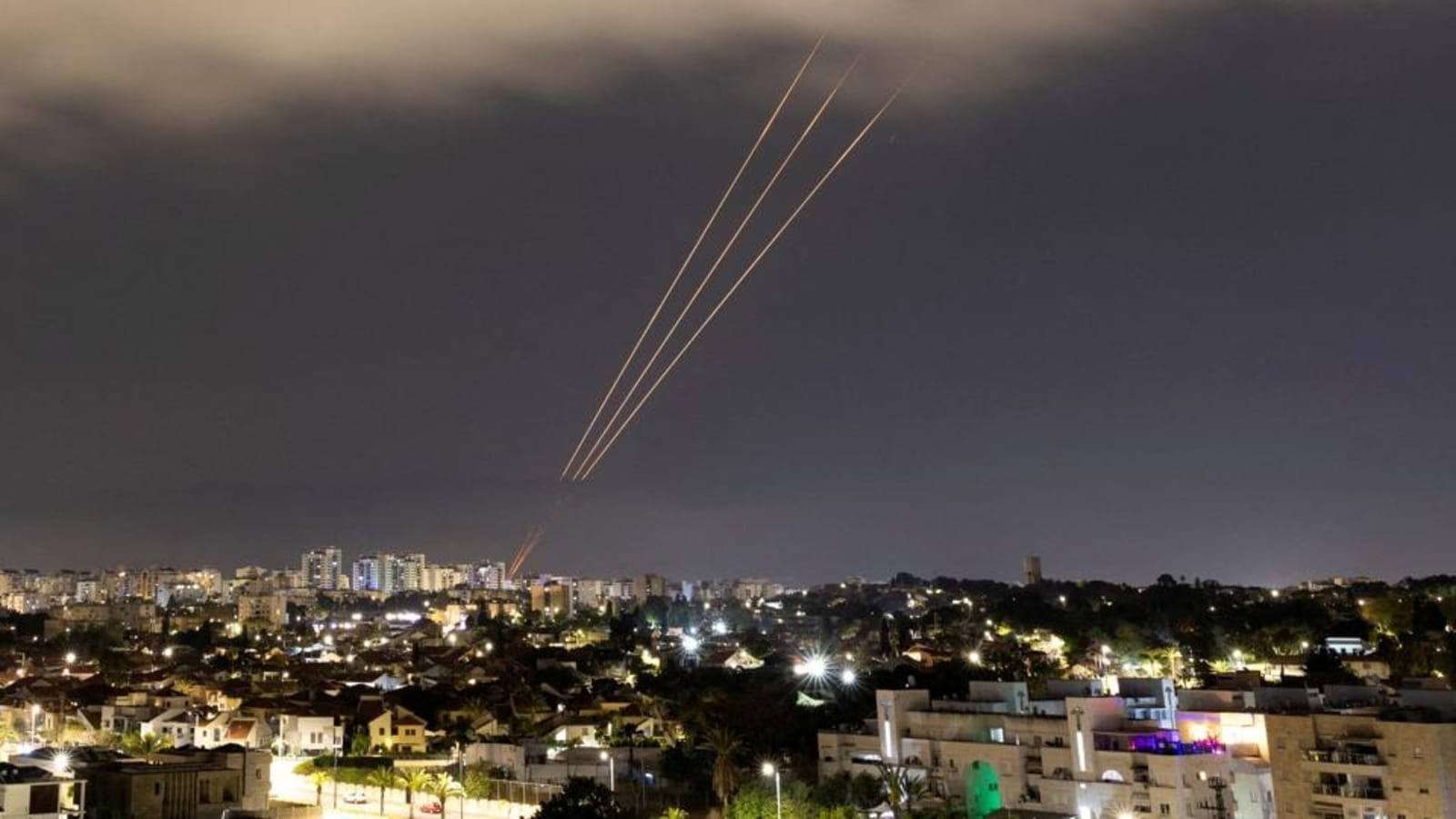latest news
Eye on the Middle East | The game of deterrence between Iran and Israel has changed

Nobel Prize-winning economist Thomas Schelling defines deterrence as preventing an adversary from any undesirable action by imposing a credible fear of consequences. The credibility of the threatened consequences is married to the actual ability to carry it out, should the adversary continue to act in an undesired way. When this ability is under question, even if the adversary’s action continues, deterrence fails. This failure is, in turn, associated with the red line that a state has set for its threatened consequences to be triggered. Hence, red lines also create commitment traps.

Iran’s attack on Israeli territory on April 13, crossed Tel Aviv’s red line. Until it reciprocates (if it does), it is Israel that is caught in a commitment trap and is staring at deterrence failure.
In the Middle East, the most famous red line in recent memory was the one set by Barack Obama in 2011: if Syria’s Bashar al-Assad employed chemical weapons amidst the growing civil war, it would cross the United States’ red line and draw “enormous consequences”. However, the Syrian Arab Army went ahead with a devastating attack on a rebel-held suburb in Damascus using Sarin gas — one of the world’s deadliest nerve agents — killing 1,400 people. The United States failed to match the level at which it had threatened consequences, looking to avoid a direct war with Syria; “The President blinked”, as David Ignatius of The Washington Post later said.
In the decade since, the red lines in West Asia have been hard to set, as the theatre of conflict features a diverse set of armed actors including Iran’s formidable paramilitary, the Islamic Revolutionary Guard Corps, and the armed proxies it trains and sustains. The large presence of the IRGC in Syria and Iraq (among Iran’s oldest regional allies, notwithstanding bilateral complications) has historically made the IRGC a plump target for Israeli air action allowing Tel Aviv to increase costs for Tehran, without direct engagement.
Since Iran itself prefers to keep the IRGC’s extraterritorial activity discreet, an Israeli attack on senior IRGC officials that Tel Aviv itself does not overtly claim sets the dynamics of deterrence. Iran is forced to respond indirectly — choosing other pressure points, such as proxy-led attacks on the forces of Israel’s main backer — the United States. Moreover, Israel itself has long conducted direct (on Iranian soil) and covert (with plausible deniability) attacks on Iran through cyber-warfare (Stuxnet in 2010, which scrambled Iranian computer networks linked to its nuclear programme) and assassinations of nuclear scientists like Mohsen Fakhrizadeh in 2021 (as The New York Times reported), among other means. Hence, both Iran and Israel have historically preferred a cat-and-mouse approach with plausible deniability, without setting overt commitment traps.
The escalation ladder
The Israeli attack on the IRGC on April 1 then was not a substantial step up but rather, it was the damage caused to the Iranian consulate in Syria during the attack that gave Tehran new rationale to declare its red-line, especially in the face of recent Israeli rhetoric calling to take the fight directly to Iran.
Through Iran’s lens, the Israeli action could be characterised as a higher-rung move in the escalation ladder — stepping out of the cat-and-mouse mode of engagement. Iran’s response, in turn, has been at a higher rung on the escalation ladder — over 200 drones and ballistic/cruise missiles launched directly at Israel. The actual damage caused and the impressive effectiveness of the combined air defence are irrelevant. As India’s former Ambassador to Israel Navtej Sarna said in a recent interview, it was meant to be more of an Iranian statement than an attack. That Iran sought to maximise spectacle is now widely recognized in analytical commentary. However, the step-up in the escalation ladder was unarguable.
Next, for Israel, which has not suffered a direct attack on its soil by another state for decades, Iran’s unprecedented move was quickly declared as a fresh breach of Tel Aviv’s red line, and effectively a declaration of war. Rhetoric aside, if Israel responds by using its older modus operandi, it is still a step down. Nothing short of a direct overt attack on Iranian territory will match the rung on the escalation ladder at which the Iranian swarm attack was set.
Fighting through proxy
As an earlier column highlighted, Iranian proxy attacks against US bases (especially in Iraq) have largely ceased since February. While in the last few months, Iran has kept up indirect back-channel communication with Washington, it took special care to give Washington room by waiting 13 days before retaliating against Israel.
The United States has responded with a preference for military de-escalation, being quick to assert that it will not support Israel in a direct war with Iran, and coaxing Israel to view the successful air defence as victory in itself. No matter the circumstances, such an over-commitment of no military support by Washington to Tel Aviv is in itself unprecedented (coming on the back of the now six-month-old war in Gaza which has killed almost 34,000 people), with the United States preferring fresh economic sanctions against Iran instead. Washington’s position is clear — it seeks to impose costs on Iran while steering clear of military entanglement — a position that may arguably be expected to continue under a possible Republican (read Trump) administration in the future.
On the other hand, regional Arab states historically hostile to Iran are currently in a detente with Tehran; this itself followed increased engagement with Israel (before October 7).
Arab states now have a low appetite for fresh military conflicts especially amidst new priorities to economically diversify. The Arab response to the Iranian strike was noteworthy: Saudi Arabia, along with UAE, Qatar, Egypt, Bahrain, Oman, Kuwait, Iraq and Jordan, all expressed “concern at escalation” and called for “restraint”. While Saudi Arabia reportedly assisted in the Israeli defence against Iranian drones and missiles by providing intelligence, Riyadh was quick to downplay its role subsequently, showing continuing Arab discomfort with new military engagement. On the other hand, as a previous column showed, Israel prefers drawing in Arab states by credibly playing up an Iranian threat, and decreasing the Arab-Israeli gap caused by the Gaza war.
Also read: Eye on the Middle East | Amidst the Iran-Israel escalation loop, India is not spoilt for choice
Thus, a combination of new geopolitical priorities in the strategic calculus of both the United States as well as regional Arab states, with the fatigue caused by the Gaza war, leaves Israel with low diplomatic backing for a same-rung response.
Indeed, the Israeli war cabinet has indicated that it reserves the right to respond with its choice of time and place but does not want a wider regional war. Such language, while loaded with escalatory potential, shows that Israel is now considering responses other than the one which would directly match Iran’s attack on Israeli soil, a response not on the same rung. Essentially, Iran has drilled unprecedented holes in Israel’s deterrence, even if by just six or seven projectiles out of over 200, and thrown the plausible deniability approach out the window. Hence, whatever Israel’s response, the Middle East is at a watershed moment.
Bashir Ali Abbas is a research associate at the Council for Strategic and Defense Research, New Delhi, and a South Asia Visiting Fellow at the Stimson Center, Washington DC. The views expressed are personal.
latest news
Slack co-founder Stewart Butterfield’s missing daughter ‘at risk’ due to ‘previous threat of suicide,’ cops say

The runaway daughter of Slack co-founder Stewart Butterfield is believed to be “at risk” because of a “previous threat of suicide,” police have said. 16-year-old Mint Butterfield was reported missing earlier this week. The teen, who is non-binary and uses they/them pronouns, reportedly fled their mother’s home in Bolinas, California.

Flickr founder Caterina Fake, Mint’s mom, alerted authorities after finding a letter they had left behind. It is believed Mint could have been on her way to San Francisco’s very dangerous Tenderloin District neighbourhood.
“At this time, we have no information to believe that Mint was taken against their will. The Sheriff’s Office is considering Mint a voluntary-missing juvenile, who is “At- Risk” due to a reported previous threat of suicide,” a statement by the Marin’s County Sheriff’s office read.
How did Mint Butterfield leave the area?
Mint fled the house with a suitcase “during the night or early morning,” according to authorities. “Fake and Mint also share a home in San Francisco, and it is believed, based on statements from Fake, that Mint may have left for the Tenderloin District of San Francisco,” the statement says.
The sheriff’s office also noted that Mint did not have access to a phone or any kind of vehicle, so it is unclear how they left the area. The San Francisco Standard reported that Mint has a history of substance abuse. They had been living with their mother before they went missing. Mint was enrolled at a private school in the Napa area.
Mint was known for having frequently visited the Tenderloin area. The area is notorious for open-air drug markets, homelessness, and violent crimes.
“Marin County Deputies entered Mint into the Missing and Unidentified Persons System (MUPS) and sent out All Points Bulletin flyers to surrounding law enforcement agencies with a description and photograph of Mint,” the sheriff’s office said.
It added, “In collaboration with San Francisco Police Department, detectives from both agencies have attempted to find Mint, but have been unable to locate them.”
Mint’s father, Stewart, co-founded Slack back in 2013. He left the company after it was acquired by Salesforce for $28 billion in 2021.
The sheriff’s office has urged people with information on the incident or Mint’s whereabouts to contact the Marin County Sheriff’s Office at (415) 479-2311 or email tips@marinsheriff.org.
Discussing suicides can be triggering for some. However, suicides are preventable. If you or someone you know is considering suicide, please contact the National Suicide Hotline at 1-800-273-TALK (8255).
latest news
KKR vs PBKS, IPL 2024: Catch all the action in images

Published on Apr 27, 2024 12:11 AM IST
- PBKS defeated KKR by eight wickets in their IPL 2024 fixture, on Friday at Eden Gardens in Kolkata.
/

View Photos in a new improved layout
Published on Apr 27, 2024 12:11 AM IST
Punjab Kings defeated Kolkata Knight Riders by eight wickets in their IPL 2024 fixture, at Eden Gardens.(PTI)
/

View Photos in a new improved layout
Published on Apr 27, 2024 12:11 AM IST
Chasing 262, PBKS reached 262/2 in 18.4 overs, courtesy of an unbeaten ton by Jonny Bairstow. Bairstow smacked an unbeaten knock of 108* runs off 48 balls and Shashank slammed 68* off 28 deliveries.(AP)
/

View Photos in a new improved layout
Published on Apr 27, 2024 12:11 AM IST
For KKR’s bowling department, Sunil Narine took a wicket.(PTI)
/

View Photos in a new improved layout
Published on Apr 27, 2024 12:11 AM IST
Initially, Phil Salt (71) and Narine (71) took KKR to 261/6 in 20 overs.(KKR-X)
/

View Photos in a new improved layout
Published on Apr 27, 2024 12:11 AM IST
For PBKS’ bowling department, Arshdeep Singh took two wickets.(ANI)
latest news
UWW threatens to suspend WFI and India’s wrestlers too

Ten days after sports ministry told the Delhi High Court that it will neither recognise nor provide any support to Wrestling Federation of India (WFI), United World Wrestling (UWW) has warned that government interference could lead to WFI being suspended again. This time, the suspension could extend to the wrestlers as well.

In a strongly-worded letter signed by UWW president Nenad Lalovic, wrestling’s global governing body has reiterated its determination to uphold WFI’s independence and autonomy.
“We have been informed that the Wrestling Federation of India is once again threatened by your Ministry of Sports with the imposition of an ad hoc committee to oversee its affairs,” UWW wrote.
“In case any decision or order should be made against your federation, and a third party be designated to run the daily affairs of our sport in India in violation of the UWW Statutes, UWW would have no other option than to re-impose a temporary suspension of your federation until further notice, and which, this time, could maybe include your athletes.
This suspension would apply to the final Olympic Games Qualifying Tournament in May, and will certainly attract the attention of the IOC on this matter, who may also consider further action,” UWW noted.
On Wednesday, a day before UWW’s letter, WFI appointed the Athletes Commission in accordance with the world body’s demand. Former Commonwealth Games gold-medallist Narsingh Yadav was elected chairman of the commission.
Ban lifted in February
UWW had placed the WFI under provisional suspension in August 2023 after WFI’s continued delay in holding elections. The ban was lifted this February. A month later, Indian Olympic Association (IOA) reinstated WFI and dissolved the three-member ad hoc committee constituted to run the sport.
WFI, however, continues to remain under suspension since last December by the ministry. Earlier this month, the ministry told the Delhi High Court that it might review the suspension only after there is visible improvement in WFI’s governance.
The ministry, in the affidavit filed through standing counsel Anil Soni, added that it would treat any national championships or competitions organised by WFI as unsanctioned and unrecognised. The Sanjay Singh-led WFI has held national championships as well as selection trials for the Olympic qualifiers.
“It is further submitted that the Ministry is continuously monitoring the governance of the WFI and at present does not deem it appropriate at this stage to review its decision dated 24/12/2023. Any review will be undertaken only after marked and visible improvement its governance, demonstration of compliance of UWW’s order and IOA’s order dated 18.03.2024 and steps taken Expiry Date 15/03/2025 WFI with regard to its democratic functioning, adherence to the Government guidelines aiming towards good governance practices including grievance redressal mechanism and safety of wrestlers,” the ministry had told the court.
In an earlier hearing this month, the court had considered setting up an ad hoc committee for running WFI.
“UWW’s letter must be taken very seriously. WFI is an autonomous body and there is no need for ministry’s suspension or interference,” Sanjay Singh said.
“The fact that UWW’s ban may extend to the wrestlers is a first in our history. The government must allow us to function independently,” a senior WFI official said.
While WFI continues to grapple with the government, Indian wrestlers’ performance has been a major cause of concern. At the Asian Olympic Qualifiers in Bishkek last week, Indian bagged quotas through Vinesh Phogat (50kg), Anshu Malik, (57kg) and Reetika (76kg), adding to Antim Panghal’s 53kg berth. The male wrestlers, both freestyle and Greco Roman, drew a blank.
-
latest news3 months ago
Why The U.S. Is Getting Serious About UFOs
-
YAHOO NEWS3 months ago
Homeowner uses ‘one of the oldest forms’ of construction to build incredible fire-resistant house that could withstand the next major blaze
-
Guardian3 months ago
Precipice of fear: the freerider who took skiing to its limits | Skiing
-
Guardian3 months ago
FA Cup roundup: Leeds beat Plymouth, Coventry set up Maidstone tie | FA Cup
-
Uncategorized3 months ago
Sending money to North Korea was risky – now it’s harder
-
Guardian3 months ago
Attacked by an ice-cream scoop? The story of London’s ‘gouged’ building | Architecture
-
Guardian3 months ago
The week in audio: Why Do You Hate Me?; Patient 11; Theory of Everything: Not All Propaganda Is Art – review | Radio
-
latest news3 months ago
BBC World News Bangla আন্তর্জাতিক সংবাদ। Today 26 Jan”2024 International Banglanews আন্তর্জাতিক খবর








